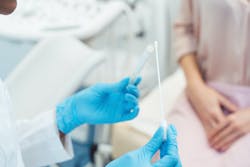Sexually transmitted infection (STI) rates are continuing to increase, especially among young people in their teens and early twenties. From 2020 to 2021, we have seen rates rise as much as 3.9% for Chlamydia trachomatis (CT) and 4.6% for Neisseria gonorrhoeae (NG).1 Underlying reasons for increases like this are not fully understood, but reduced access to healthcare during the COVID-19 pandemic may have contributed to these increasing rates by allowing infections to persist longer, creating more opportunity to spread disease. Undetected and untreated, STIs can lead to serious long-term health complications like pelvic inflammatory disease (PID) or infertility. To help detect and control the spread of STIs we know it is important to use effective screening with optimal testing procedures. After many years of clinical use and over 20 years of data collection, it has been apparent for some time that vaginal swabs are the most effective method to screen for STI testing,2 and laboratories play an important role assisting healthcare professionals (HCPs) in providing the best test to their patients.
When it comes to STI’s, treatment and prevention hinge on effective screening and adherence to recommended treatment guidelines. The Centers for Disease Control and Prevention (CDC) and The United States Preventive Services Task Force (USPSTF) recommend screening for CT and NG in all sexually active women 24 years or younger and in women 25 years or older who are at increased risk for infection.3,4 Having anal, vaginal, or oral sex without a condom or having multiple sex partners can all lead to an increased risk of getting an STI.5 The CDC also recommends considering annual Trichomonas vaginalis (TV) screening for people in high-prevalence settings (i.e., STI clinics and correctional facilities) and for asymptomatic women at high risk for infection.1 And finally, Mycoplasma genitalium (M. gen.) infection should be suspected in cases of persistent or recurrent urethritis or cervicitis and considered for those with pelvic inflammatory disease (PID).
Appropriate treatment for STIs requires accurate identification of the pathogen. The CDC and the American College of Obstetricians and Gynecologists (ACOG) recommend using nucleic acid amplification tests (NAATs) for CT, NG, and TV due to their high diagnostic accuracy. Additionally, the CDC recommends NAAT as the preferred method for detecting M. gen.
As a first step, STI testing accuracy depends on optimal sample types collected from patients. A recent meta-analysis of studies comparing vaginal swabs and urine revealed that vaginal swabs are the optimal sample type for CT, NG, and TV testing.2 Vaginal swab samples were also found to deliver greater testing sensitivity compared with urine samples.2 As a result of this loss in sensitivity, use of urine samples rather than vaginal swabs was predicted to lead to >400,000 missed cases of CT, NG and TV annually based on current prevalence data for these infections.6 Additionally, there is an issue of likely lower organism load in asymptomatic women, meaning that the most sensitive test is clearly called for to help detect if there is an infection.
Due to this greater sensitivity, the CDC recommends the use of vaginal swabs for female STI screening.7 In a clinic setting, vaginal swab samples can be obtained by patients themselves or by an HCP. Patients are also expressing their support for this option. In a survey regarding the ease of self-collection and preferences for a vaginal swab, urine, or cervical swab, 76% of women preferred vaginal swab over cervical swab, 60% over a urine collection, and 94% indicated that they would be tested more often if a vaginal swab was available.8
Despite a collection of studies indicating vaginal swabs show superior sensitivity, adoption in clinical practice has been poor. A recent meta-analysis showed that fewer than 10% of labs receive vaginal swabs more frequently than other sample types, like urine samples.2 Clinic preferences for sample type typically vary based on the workflow that has already been established by practices. For example, family planning clinics that conduct many pregnancy tests with urine samples, frequently use these samples for concurrent STI testing due to ease of efficiency. And some family practices assume that urine sampling may be more palatable for adolescent patients if family is present. However, what providers may not be aware of is the difference in efficacy between vaginal swabs and urine, as they often rely on outdated data, incorrect assumptions, or use the quickest way to receive a sample. While there may be a perceived loss of efficiency by moving away from using prior collected urine, having the patient collect a self-swab sample along with leaving a urine sample or while they are waiting for the provider could be as efficient and more accurate.
We can work to change this habit! There are multiple approaches laboratories can adopt to further support HCPs in providing the best test to their patients. Clinical laboratories can play a more prominent role in educating HCPs, including provider groups, on the advantages of using vaginal swabs for STI testing. They can share their data on the higher sensitivity of vaginal swabs (fewer false negatives) compared with urine samples, how to seamlessly integrate vaginal swab sample collection (clinician or patient self-collection) into any workflow arrangement, and how testing for multiple STIs can be streamlined using the same collection devices. All of these approaches can lead to lower rates of patient call-backs and remove the need for HCPs to store different collection devices in their offices.
Laboratory experts can also help HCPs stay up to date with the latest information on how assay technologies differ in their clinical performance. In addition to providing performance data, laboratories can also keep HCPs apprised of local/regional STI prevalence to promote community sexual health. Together, laboratories and HCPs can work toward improving patient care with the use of vaginal swabs in clinical practices by incorporating one or several of these approaches. Engagement and communication between laboratories and HCPs are critical to achieve this. Helping physicians be more informed allows them to select the best testing methods and can help lead to improving accuracy of detection in STI screening and lowering infection rates with the use of vaginal swabs.
References
1. Sexually transmitted disease surveillance, 2021. Cdc.gov. Published April 11, 2023. Accessed October 30, 2023. https://www.cdc.gov/std/statistics/2021/default.htm.
2. Aaron KJ, Griner S, Footman A, Boutwell A, Van Der Pol B. Vaginal Swab vs Urine for Detection of Chlamydia trachomatis, Neisseria gonorrhoeae, and Trichomonas vaginalis: A Meta-Analysis. Ann Fam Med. 2023;21(2):172-179. doi:10.1370/afm.2942.
3. US Preventive Services Task Force; Davidson KW, Barry MJ, et al. Screening for Chlamydia and Gonorrhea: US Preventive Services Task Force Recommendation Statement. JAMA. 2021;14;326(10):949-956. doi:10.1001/jama.2021.14081.
4. STI screening Recommendations. Cdc.gov. Published June 6, 2022. Accessed October 30, 2023. https://www.cdc.gov/std/treatment-guidelines/screening-recommendations.htm.
5. STD facts - HIV/AIDS & STDs. Cdc.gov. Published June 7, 2022. Accessed October 30, 2023. https://www.cdc.gov/std/hiv/stdfact-std-hiv.htm.
6. Wood SM, Fiks AG. Growing Evidence Supports an Implementation Shift Toward Vaginal Sampling for Chlamydia trachomatis, Neisseria gonorrhoeae, and Trichomonas vaginalis Screening. Ann Fam Med. 2023;21(2):100-102. doi:10.1370/afm.2959.
7. Recommendations continued. Cdc.gov. Published January 12, 2019. Accessed October 30, 2023. https://www.cdc.gov/std/laboratory/2014labrec/recommendations2.htm.
8. Chernesky MA, Hook EW 3rd, Martin DH, et al. Women find it easy and prefer to collect their own vaginal swabs to diagnose Chlamydia trachomatis or Neisseria gonorrhoeae infections. Sex Transm Dis. 2005;32(12):729-33. doi:10.1097/01.olq.0000190057.61633.8d.
About the Author

Kyle Bukowski, MD
is a double board-certified OB/GYN and Complex Family Planning sub-specialist. He serves as the Chief Medical Officer for Planned Parenthood of Maryland, and in this role, Dr. Bukowski promotes the mission of ensuring Marylanders and anyone traveling to Maryland have broad access to high-quality, affordable sexual and reproductive health services. Dr. Bukowski received his medical degree and completed his residency at the David Geffen School of Medicine at UCLA.
